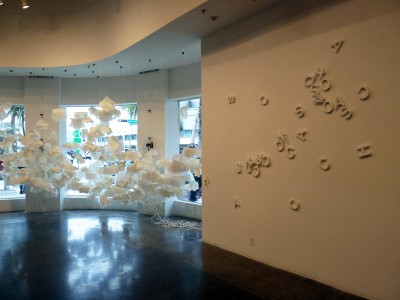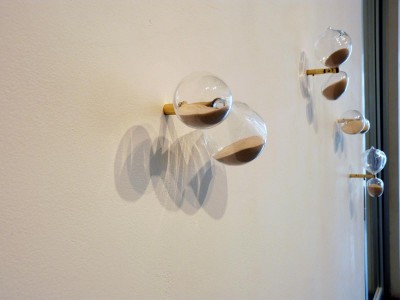
A constructive engagement, from Brazil to Miami Beach
Constructivism as an art form first arose in the revolutionary era of Russia, a precursor of sorts to Bauhaus and other movements that combined architectural, material and design elements, with the aim of taking art from the walls of museums and making it more interactive and public. Today, constructivism’s influence can be felt all over contemporary art, in the prevalence of installation art, minimalism, in the use of non-traditional materials, in the interest of exploring space, including public space.
One example here in Miami: Brazilian Laura Vinci, who is making her American debut with the exhibit at the ArtCenter/South Florida, “Untitled: From the Series Papeis Avulsos” (although her work has been seen at Art Basel Miami Beach before). She uses Japanese paper, metal piping, marble, glass bowls filled with water to create her pieces. And she wants her pieces to interact with viewers — and a particular space — in a way that differs from static forms such as painting and drawing.
In the front of the gallery, where the windows face busy Lincoln Road, white sheets of fragile Japanese paper hang, creating small cloud formations that gently move thanks to wires and a man-made “wind.” On the wall behind, off-white alphabetical letters that would spell out “chaos” if they were properly placed, make up another installation. In this exhibit, the pieces are there; it’s up to you to put them together.
Wall works of hourglasses filled with industrial sand from Brazil; photo by Lujan Candria.
According to curator Elizabeth Cerejido, women have made some of the biggest footprints in contemporary Brazilian art, based in conceptual and constructivist backgrounds. “Brazilian artists, particularly women like Lygia Clark or Lygia Pape, have taken the ideas of constructivism and other related concrete movements and put heart, body and soul into them,” she says. “They played an enormous role in bringing modern art to Brazil.”
Cerejido and Vinci will talk about this unique history, and the artist’s influence, Wednesday, July 23. This is the kind of conversation Miami needs to cement a place as a center for Latin cultural arts.
“Laura Vinci: Untitled” runs through Sept. 7; Conversation with Vinci and Elizabeth Cerejido, Wed., July 23 at 7 p.m., at the ArtCenter/South Florida, 800 Lincoln Rd., Miami Beach, www.artcentersf.org.
Recent Content
-
Artsarticle ·
-
Artsarticle ·
-
Artsarticle ·


